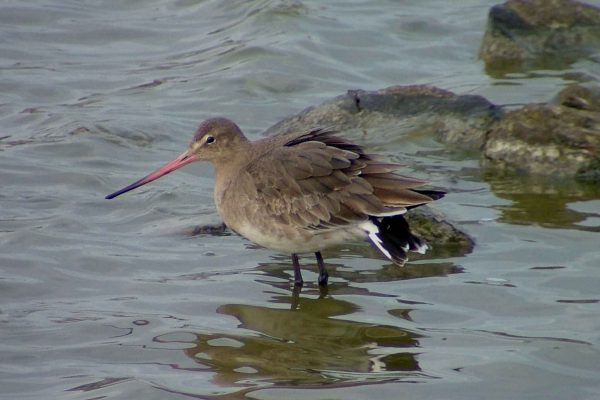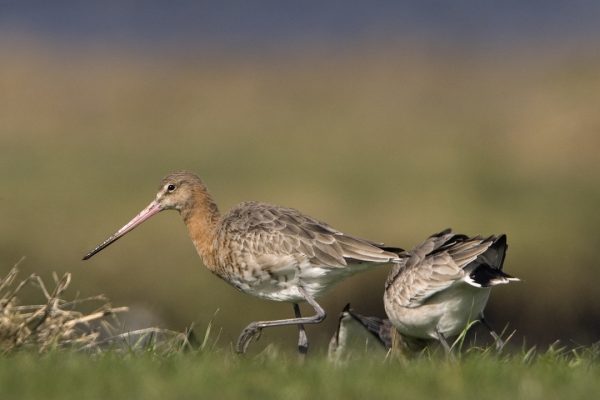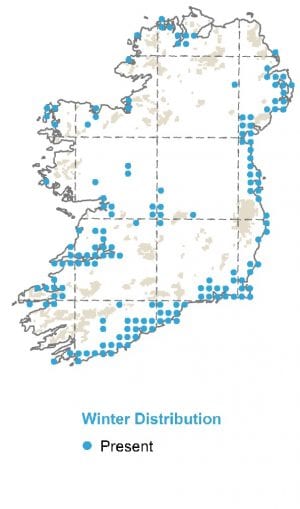
Black-tailed Godwit
| Irish Name: | Guilbneach earrdhubh |
| Scientific name: | Limosa limosa |
| Bird Family: | Waders |
red
Conservation status
Conservation status
Status
Winter visitor from Iceland. Numbers remain high throughout the winter, especially September.
Identification
Very similar in size and shape to Bar-tailed Godwit, but the slightly longer, straighter bill, neck and legs give it a more elegant appearance. Winter plumage is a similar greyish brown to Bar-tailed, but generally plainer, with less dark-centred feathers, especially on the wings. In flight, the similarities between the godwits disappears - Black-tailed shows a striking contrasty upperwing - mostly black with bold white wingbars, a square white rump and a black tail (Bar-tailed has quite uniform brown wings and a long white rump which extends well up the back forming a white wedge). Summer plumaged or moulting birds often occur, showing varying amounts of rich orange. Typically wades in shallow water on tidal mudflats - favours the inner, more silty parts of estuaries and inlets. Can occur in large flocks of several hundred birds.
Voice
Described as loud 'wicka' repeated three times.
Diet
Visual and tactile feeders - feed on a range of invertebrates, including bivalves, polychaete worms and shore crabs. Prefer to feed on muddier estuaries, but also feed in brackish pools and on nearby rough pasture. While on pasture, they feed on the larvae of crane fly (Tipulidae) and on the amphipod Corophium volutator. They have also been recorded feeding on grain in stubble fields on the Wexford Slobs.
Breeding
Breed in lowland wet grassland and marshes. Nine breeding sites were identified in Ireland during the last breeding atlas. More recently, birds were present during the breeding season between 1996 and 1999 inclusive, though breeding was not proven.
Wintering
Winters in a variety of habitats, both inland (particularly grassland and river deltas) and coastal (particularly estuaries), though seldom seen along non-estuarine coast.
Monitored by
Blog posts about this bird

A Summer evening on Sandymount Strand
Over the summer we have been working in Dublin Port on our tern conservation project, funded by the Dublin Port Company. This project focuses on the Common and Arctic tern populations that breed within the Port area. Both Common and Arctic Terns are ‘Amber- listed’ species in Ireland - meaning they are of ‘medium conservation concern’ - and the colony that nests within Dublin Port is the third largest in the Republic of Ireland.
Terns have the longest migration of any animal. Arctic Terns, as their name might suggest, have a breeding range that extends up to the Arctic circle during our summer, before migrating down to their feeding grounds in Antarctica during our winter. Though Common Terns don’t migrate as far as this, with Irish- breeding Common Terns migrating down as far as the west coast of Africa during our winter, it is still an impressive distance to travel for a bird that doesn’t weigh much more than 100g.
Part of the work we do to monitor and protect terns in the port involves the ringing of chicks and adults,. This is when we add uniquely coded metal and colour ID rings to individual birds so that we can identify them. This work helps us to assess survival rates, site fidelity (i.e. do individuals return to the same place to breed every year, or do they move elsewhere), as well as to identify migration routes when birds are resighted travelling to and from their breeding grounds.







(Above: Arctic Tern fitted with metal and colour ID rings, under BTO and NPWS licence)
Over the summer, most of our ringing work has focused on tern chicks - if you follow us on social media, you may already have seen some of our posts relating to this (and if you haven’t, go ahead and give us a follow to keep updated on our important information, including many cute pictures of birds – links at the bottom of this article). However, as summer draws to an end, and the chicks start to fledge and join the adults to begin their long migration south, we change tactics with the aim of capturing adults rather than chicks. To do this, we set up mist nests near their evening roost sites. You can see how this looks in the photos below (just!!). It’s a task easier said than done. It requires the right tides to align with the right time and because of this we usually only get one opportunity a year to ring adult and fledgling terns in this way, so it is an exciting opportunity whenever it arises. And luckily, this year did not disappoint!

(Above 1 & 2, the team setting up the mist nets in the fading light over Dublin Bay)
We caught not only terns, but also Oystercatchers, Redshanks, Turnstones and even a Black-tailed Godwit! With over 60 birds captured, we caught more birds this year than in the previous five put together. A fantastic day for us which offers us an opportunity to learn much more about these birds in the years to come. And while that will be the last of the terns we catch this summer as they migrate away, it will hopefully be the first of the waders as they make their way to overwinter in Ireland.
(Above: a night vision scope used to see when a bird has been caught in the net)
The highlights of this mammoth haul include; a Common Tern that was ringed in Senegal whilst migrating northwards in the spring, offering us an insight into the migration paths that our Common Terns take; and we had a resighting of a Common Tern that was ringed in 2010., For a species that lives on average to around 10 years old, a resighting of a 15-year-old is pretty special; we colour- ringed three Turnstones, which is part of a new project on this species and so we are delighted to be able to ring these for the first time; and we also had a resighting of an Oystercatcher, which helps build our knowledge on the site fidelity of this species and their migration routes between their summer breeding and winter feeding grounds. All in all, it was a great night s outing for us and we will be keeping everything crossed for the same again next year! Until then, follow us on Facebook, Instagram and X for updates on all of our ongoing work. If you would like to support us and to make a direct contribution to the protection of Ireland’s birds and biodiversity, please do so by becoming a member here and signing up for our members only newsletter, Wings, alongside many more members only benefits.
(Above: Redshank fitted with metal and colour ID rings)
All photos taken under NPWS license and all handling and ringing is done by trained and licensed bird ringers. The Dublin Bay Birds Project is funded by

Record attendance at I-WeBS workshops highlights public appetite to support biodiversity
The high attendance at two recent introductory Irish Wetland Bird Survey (I-WeBS) workshops in Galway highlighted an increasing public desire to learn about and support biodiversity.
Organised by BirdWatch Ireland in collaboration with Galway County Council and Galway City Council with the support of the NPWS, the workshops were aimed at showing birdwatchers how they can help monitor wintering waterbird populations at Inner Galway Bay and in turn, inform their conservation. Additionally, BirdWatch Ireland also hoped to recruit new skilled I-WeBS observers to survey this important site during the 2023/ 24 season.
Over 120 people attended the workshops across the two days. The training days, which involved a combination of informative talks about the I-WeBS survey followed by an outdoor field method demonstration, were held on the 23rd September at Knocknacarra Community Centre and the 6th of October the Marine Institute. Within the talks, attendees found out about why it is so important to survey our wintering waterbirds as well as some hot tips for identifying and counting waterbirds. To pick up some tips and tricks for identifying waterbirds, take a look at the I-WeBS training tools.



Workshop participants getting a glimpse of some interesting waterbirds at Rinville.
The outdoor portion of the events – which took place at Rusheen Bay and Rinville – proved fruitful, offering views of waterbirds such as Lapwing, Curlew, Turnstone and Sandwich Terns, to name but a few. Although not a waterbird, the sight of a beautiful female Wheatear hopping along the nearby rocks was a delightful bonus. Attendees brought with them a wealth of relevant experiences, skills and interests, with a high number of local university students and ecological consultants particular taking part. The interactive and informative workshops have thus far resulted in the recruitment of 30 new I-WeBS volunteers for Inner Galway Bay, with many more attendees choosing to sign up to survey at other sites. Meanwhile, the events inspired many more to get involved with their local Galway Branch of BirdWatch Ireland. In addition to boosting survey volunteer numbers, the recent events also offered a fantastic platform to spread the word about I-WeBS – a National Parks and Wildlife Service (NPWS) funded monitoring project that has been running since 1994. Every year between September and March, close to 500 I-WeBS volunteers record wintering waterbirds at important wetland sites around the country. Irish wetlands are extremely important for the survival of these birds and I-WeBS keeps track of how these birds are faring so that informed conservation action can be taken.
Participants working together to identify birds at Rinville.
The recent I-WeBS workshops focused predominantly on Inner Galway Bay – an internationally important site for wintering waterbirds, hosting over 20,000 birds every season. Inner Galway Bay is a site of international importance for the Great Northern Diver and Light-bellied Brent Goose, meaning that it regularly supports one per cent or more of the flyway population of these species. It is also a site of national importance for many birds, including Red-listed species such as Shoveler, Grey Plover, Dunlin, Redshank, Black-tailed Godwit, Bar-tailed Godwit and Lapwing. In all, the workshops proved to be a great success, in large part due to the strong collaboration between BirdWatch Ireland, BirdWatch Ireland’s Galway Branch, Galway County Council, Galway City Council, the Marine Institute and Knocknacarra Community Centre. BirdWatch Ireland is particularly grateful to Galway County Council and Galway City Council for funding binoculars and telescopes, which will be available for survey volunteers to rent from Galway City Library.








